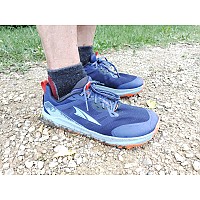Falcon Guides Ultralight Backpackin' Tips

The good/beneficial advice presented in this book simply cannot make up for the REALLY BAD opinions that the author brings forth as part of Ultralight (UL) backpacking.
Pros
- Caused me to reconsider what I'm carrying in my pack
- Definitely helped me lighten my pack weight
Cons
- Some advice is not just foolish, but potentially life-threatening.
<<I borrowed it = Library book>>
Opinions are like armpits--Everyone has a couple and some of them stink. The problem is when someone with stinky opinions gets himself published, many begin to accept those opinions as fact. Mike Clelland has had the good fortune of finding a publisher looking to cash in on the UL craze.
However, I want to emphatically state if you are new to backpacking, stay far away from this book. Any experienced backpacker will immediately recognize some seriously bad advice. I'll touch on three key ones:
- LACK OF FOOD: In the attempt to shave every possible ounce from your pack, Clelland states that if you return to your car with any amount of food remaining, you packed to much. He goes so far to write that hiking hungry on your last day is perfectly acceptable and won't hurt anyone.
On the surface, Clelland is right. Finishing your hike and driving to the closest burrito join isn't all that bad. However, that advice assumes nothing goes wrong. It doesn't take into account being held up by a late season snowstorm, or finding a washed out trail that requires hours of backtracking, or a twisted ankle that cuts your hiking speed in half.
Calories are a necessity, not a luxury on the trail. Calories keep you warm when it's cold. Calories keep you fueled. Clelland would have you risk being caught without enough food to deal with an emergency for the sake of a few ounces.
_________________ - LACK OF SHELTER: It's common for UL hikers to sleep under a tarp with a thin foam pad. That's not what I'm referring to. Clelland's approach to a shelter sleep system is to carry the lightest bag possible by selecting a bag with a temperature rating higher than forecasted temps and supplementing with the clothes you are wearing.
For example, if evening temps are forecasted to be in the mid-30's, Clelland advocates carrying a 40-degree bag and wearing all your clothes to bed. Further, he dismisses the idea of carrying extra clothes to sleep in (He sarcastically refers to these as "pajamas.").
Again, Clelland's dangerous advice assumes nothing goes wrong. This reviewer has never been on a week-long trip when temperatures didn't turn unexpectedly colder than forecasted. Further, climbing soaking wet into an inadequate sleeping bag may keep you warm. Then again, you may just succumb to hypothermia during the night.
[I'm reminded of a wet caving trip when a new guy announced he wasn't going to wear a wetsuit. After some back-and-forth conversation, the trip leader told him he either put it on, or we were all going home. Fifteen hours later, the guy admitted his plan was foolish and that he would have put the group at risk by not being adequately prepared for the environment.]
_________________ - LACK OF FIRST AID: I'll be blunt, if my potential injuries can be fixed with just an aspirin and a band-aid, then I don't need a First Aid Kit (FAK). I can hike with a bleeding scratch and a headache. Yet, these are the only two items Clelland says you need. Once again, this book assumes the best and ingnores the worst. That assumpution is dangerous.
Granted, many of the FAK sold in outdoor gear stores are heavy and filled with unecessary items. However, any FAK should be adequate to deal with the situation until help arrives or can be reached.
Clelland wants you to carry a sub-1oz bandaid and pain reliever. Because he does not even carry a full bandana (He advocates cutting that into a long, single strip), even that resource is lost. Here's a video of my 6oz FAK that provides for the unexpected. Some may argue they want to carry more than this, but I believe this setup is adequate and for more substantial than what Clelland advocates:
The book goes on to provide other tips. Some of them are useful (like buying a scale and weighing every piece of gear you own). Some of them don't thrill me (like wiping your butt with rocks...seriously!).
On the positive side, this book did help me shave significant weight from my pack. My baseweight went from 28lbs to 15lbs. For example, Clelland opened my eyes to the fact that my MSR Groundhog Tent Stake digs a cathole just as well as my cheap, plastic trowel. So why carry the extra 4oz? I also know that were I willing to cut a few extra "luxuries," I could easily be at that magic "10 pound" UL baseweight.
BUT UL hiking is suppose to be about being comfortable. If comfort were solely measure by the ache in your shoulders, then Clelland's advice makes sense. But that is a one dimensional measurement. Where is the comfort when I'm hungry and cold, with a root in my back and wet socks on my feet?
Summation: There are some useful tips in this book, but a knowledgeable reader will recognize some terrible advice. Clelland convinced a publisher of the sales potential for an UL title. That doesn't make his printed opinions sound or safe. If you read this book, keep that in mind.
Source: borrowed it



